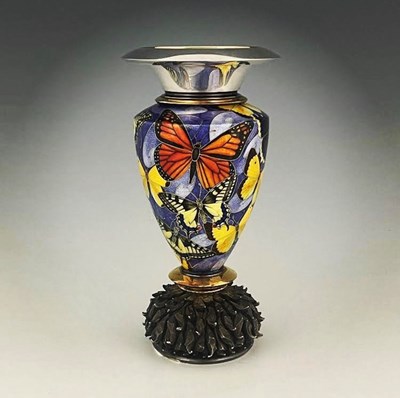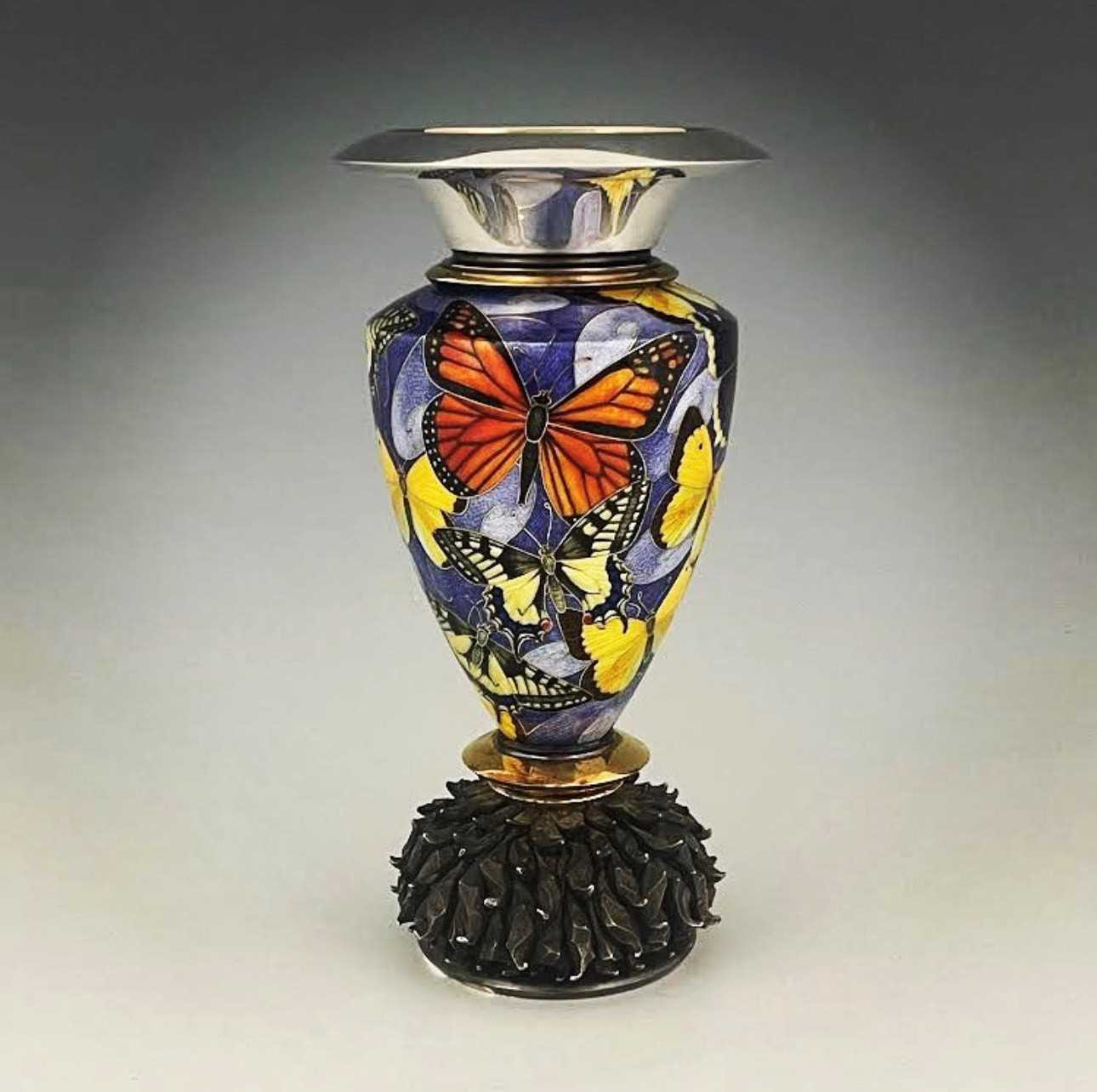22nd Mar, 2024 10:00
Silver and Objects of Vertu
147
(†) Fred Rich.
An Elizabeth II silver and enamel vase, of baluster form with gilt upper and lower bands and flared rim, with textured rocaille to the foot, the body cloisonné and basse-taille enamelled in polychrome with species of anatomically correct butterflies, atop a graduated blue ground, the underside signed, "Fred Rich", and struck with the millennium mark, sponsor’s mark, ‘FR’ in quatrefoil surround, and hallmarked for London 2000, height 24.8cm, weight 2297g/73.85ozt gross approx., ensuite with a lined fitted presentation case from Fred Rich Enamel Design. This piece is pictured on the front cover of the accompanying promotional booklet.
Provenance: Private collection, United Kingdom.
(†) Artist's Resale Right/Droit De Suite applies. Refer to our Terms and Conditions of Business.
Catalogue Note: According to the literature accompanying this piece, 'Fred Rich is considered by many to be Britain's most dynamic and versatile art enameller, he has won innumerable art awards and his work is represented in all the major public collections in the UK as well as in many private collections worldwide. Most of his work is made for private commissions, with larger pieces taking many months of painstaking and arduous work, resulting in a very small output.'
According to Andrew & Styles (2015), Fred Rich explains, 'I start with the form, a vase for example. The enamelled design has to be scribed onto the surface before 22-carat gold wire is applied and soldered on. This "draws" the design on to the vase. However, each piece of gold wire has to be cut and bent to shape before being soldered on. This can mean that hundreds of small pieces of gold wire are used in one design. Once the design is in place, the metal is hand-carved in relief. This not only removes the fire-stain from the metal, but gives the enamel definition and vitality and the resulting play with light makes a huge difference to the pictorial effect - transparency gives the whole piece life…The application of the enamel is an extremely painstaking process. Several layers of enamel have to be applied, working in sections at a time and each layer has to be fired at extremely high temperatures...this whole process can mean that larger pieces are fired in the kiln up to 40 times! You cannot cut corners with enamel and I do get hyper-critical with my work - it's the only way I know to maintain a standard.'
Reference: Andrew, J. and Styles, D. (2015). Designer British Silver: from studios established 1930-1985. Woodbridge, Suffolk: Antique Collectors’ Club.
Sold for £13,000
(†) Fred Rich.
An Elizabeth II silver and enamel vase, of baluster form with gilt upper and lower bands and flared rim, with textured rocaille to the foot, the body cloisonné and basse-taille enamelled in polychrome with species of anatomically correct butterflies, atop a graduated blue ground, the underside signed, "Fred Rich", and struck with the millennium mark, sponsor’s mark, ‘FR’ in quatrefoil surround, and hallmarked for London 2000, height 24.8cm, weight 2297g/73.85ozt gross approx., ensuite with a lined fitted presentation case from Fred Rich Enamel Design. This piece is pictured on the front cover of the accompanying promotional booklet.
Provenance: Private collection, United Kingdom.
(†) Artist's Resale Right/Droit De Suite applies. Refer to our Terms and Conditions of Business.
Catalogue Note: According to the literature accompanying this piece, 'Fred Rich is considered by many to be Britain's most dynamic and versatile art enameller, he has won innumerable art awards and his work is represented in all the major public collections in the UK as well as in many private collections worldwide. Most of his work is made for private commissions, with larger pieces taking many months of painstaking and arduous work, resulting in a very small output.'
According to Andrew & Styles (2015), Fred Rich explains, 'I start with the form, a vase for example. The enamelled design has to be scribed onto the surface before 22-carat gold wire is applied and soldered on. This "draws" the design on to the vase. However, each piece of gold wire has to be cut and bent to shape before being soldered on. This can mean that hundreds of small pieces of gold wire are used in one design. Once the design is in place, the metal is hand-carved in relief. This not only removes the fire-stain from the metal, but gives the enamel definition and vitality and the resulting play with light makes a huge difference to the pictorial effect - transparency gives the whole piece life…The application of the enamel is an extremely painstaking process. Several layers of enamel have to be applied, working in sections at a time and each layer has to be fired at extremely high temperatures...this whole process can mean that larger pieces are fired in the kiln up to 40 times! You cannot cut corners with enamel and I do get hyper-critical with my work - it's the only way I know to maintain a standard.'
Reference: Andrew, J. and Styles, D. (2015). Designer British Silver: from studios established 1930-1985. Woodbridge, Suffolk: Antique Collectors’ Club.
Auction: Silver and Objects of Vertu, 22nd Mar, 2024
You can bid in the room, leave commission bids, book a telephone line, or access the auction via one of five online bidding platforms, including Kinghams Live, a commission free live bidding platform. Auction begins at 10am
Condition reports
Please note that condition reports are not printed in the catalogue or online, however we are happy to provide them when requested subject to our terms and conditions of sale. The absence of any reference to condition in any description does not imply the lot is without fault. Please contact enquiries@kinghamsauctioneers.com for further information.
Lift Access:
Please note our lift is currently out of order and access to the auction room for bidding is by staircase only.
Viewing
Wednesday - 10:00am to 5:00pm
Thursday - 10:00am to 5:00pm
Friday - 9:00am to 10:00am

















